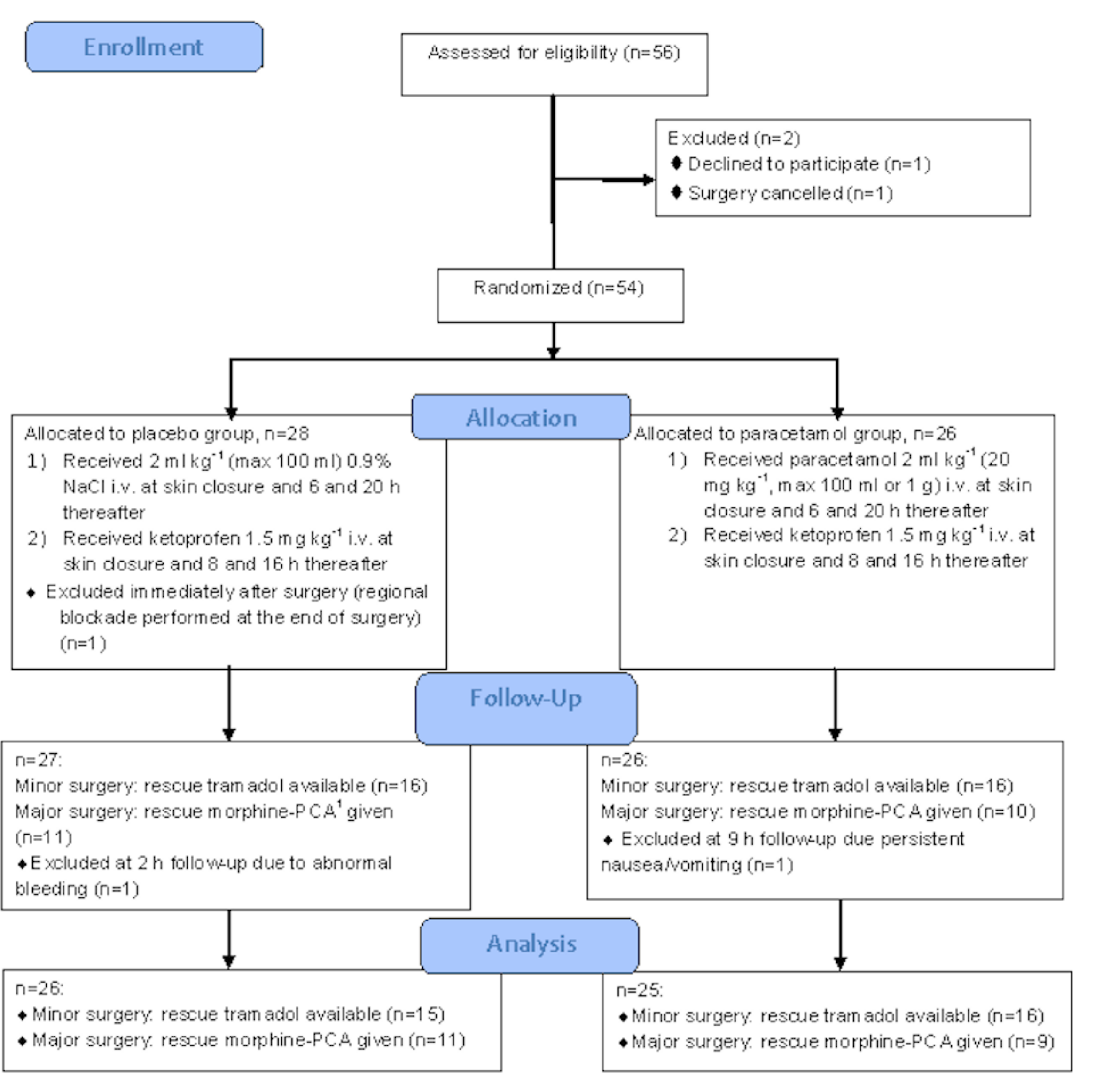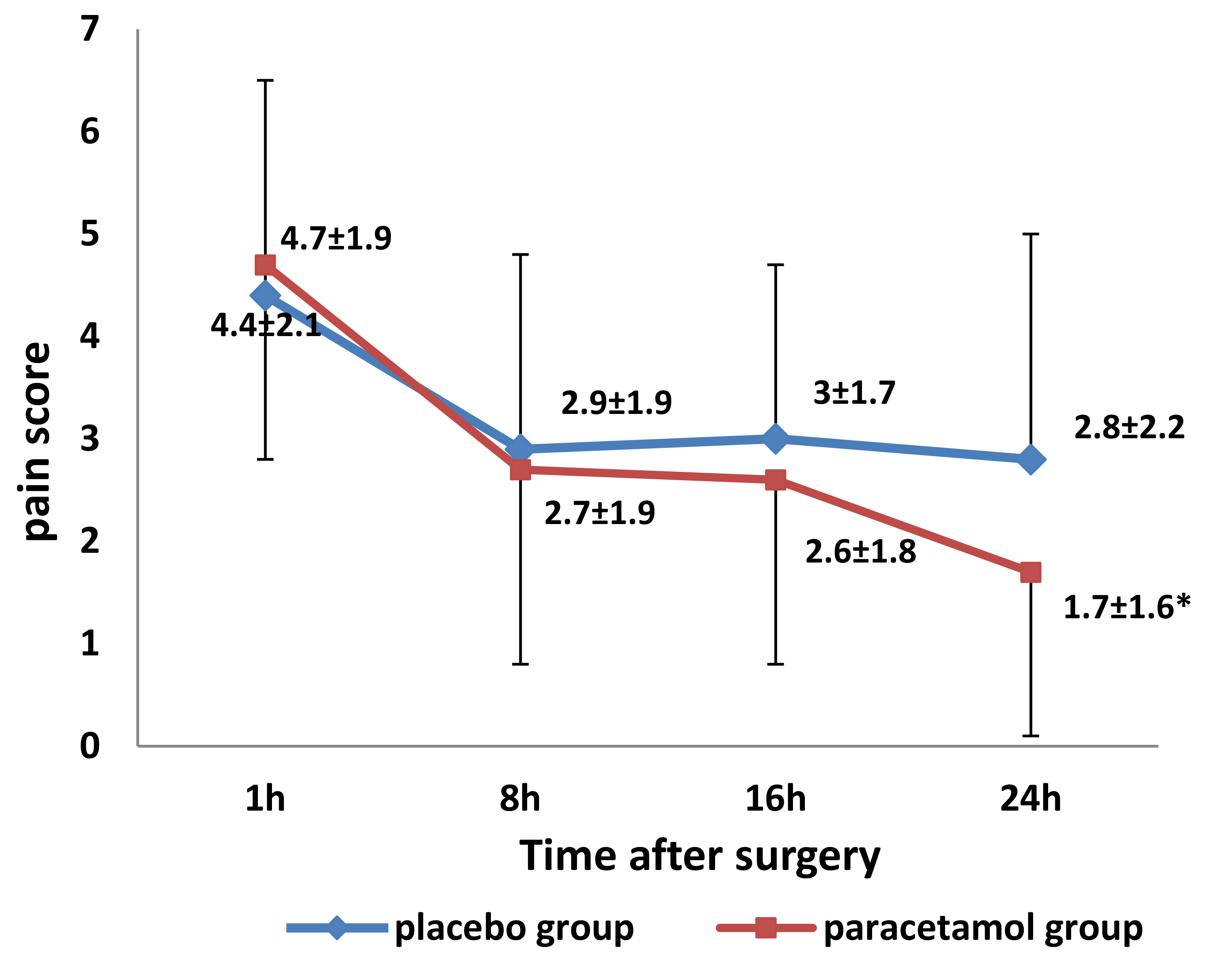Intravenous Paracetamol in Adjunct to Intravenous Ketoprofen for Postoperative Pain in Children Undergoing General Surgery: A Double-Blinded Randomized Study
Abstract
:1. Introduction
2. Materials and Methods
Statistical Methods
3. Results
4. Discussion
5. Limitations
6. Conclusions and Clinical Implications
Author Contributions
Funding
Conflicts of Interest
References
- Michelet, D.; Andreu-Gallien, J.; Bensalah, T.; Hilly, J.; Wood, C.; Nivoche, Y.; Mantz, J.; Dahmani, S. A meta-analysis of the use of nonsteroidal antiinflammatory drugs for pediatric postoperative pain. Anesth. Analg. 2012, 114, 393–406. [Google Scholar] [CrossRef]
- Kokki, H. Ketoprofen pharmacokinetics, efficacy, and tolerability in pediatric patients. Paediatr. Drugs 2010, 12, 313–329. [Google Scholar] [CrossRef] [PubMed]
- Vittinghoff, M.; Lönnqvist, P.A.; Mossetti, V.; Heschl, S.; Simic, D.; Colovic, V.; Dmytriiev, D.; Hölzle, M.; Zielinska, M.; Kubica-Cielinska, A.; et al. Postoperative pain management in children: Guidance from the pain committee of the European Society for Paediatric Anaesthesiology (ESPA Pain Management Ladder Initiative). Paediatr. Anaesth. 2018, 28, 493–506. [Google Scholar] [CrossRef]
- Wong, I.; St John-Green, C.; Walker, S.M. Opioid-sparing effects of perioperative paracetamol and nonsteroidal anti-inflammatory drugs (NSAIDs) in children. Paediatr. Anaesth. 2013, 23, 475–495. [Google Scholar] [CrossRef] [PubMed]
- Hiller, A.; Helenius, I.; Nurmi, E.; Neuvonen, P.J.; Kaukonen, M.; Hartikainen, T.; Korpela, R.; Taivainen, T.; Meretoja, O.A. Acetaminophen improves analgesia but does not reduce opioid requirement after major spine surgery in children and adolescents. Spine 2012, 37, E1225–E1231. [Google Scholar] [CrossRef] [PubMed]
- Ong, C.K.; Seymour, R.A.; Lirk, P.; Merry, A.F. Combining paracetamol (acetaminophen) with nonsteroidal antiinflammatory drugs: A qualitative systematic review of analgesic efficacy for acute postoperative pain. Anesth. Analg. 2010, 110, 1170–1179. [Google Scholar] [CrossRef]
- Weatherall, M.; Ioannides, S.; Braithwaite, I.; Beasley, R. The association between paracetamol use and asthma: Causation or coincidence? Clin. Exp. Allergy 2015, 45, 108–113. [Google Scholar] [CrossRef] [PubMed]
- Pogatzki-Zahn, E.; Chandrasena, C.; Schug, S.A. Nonopioid analgesics for postoperative pain management. Curr. Opin. Anaesthesiol. 2014, 27, 513–519. [Google Scholar] [CrossRef] [PubMed]
- Rugyte, D.; Kokki, H. Intravenous ketoprofen as an adjunct to patient-controlled analgesia morphine in adolescents with thoracic surgery: A placebo controlled double-blinded study. Eur. J. Pain 2007, 11, 694–699. [Google Scholar] [CrossRef] [PubMed]
- McGrath, P.A.; Seifert, C.E.; Speechley, K.N.; Booth, J.C.; Stitt, L.; Gibson, M.C. A new analogue scale for assessing children’s pain: An initial validation study. Pain 1996, 64, 435–443. [Google Scholar] [CrossRef]
- Voepel-Lewis, T.; Merkel, S.; Tait, A.R.; Trzcinka, A.; Malviya, S. The reliability and validity of the Face, Legs, Activity, Cry, Consolability observational tool as a measure of pain in children with cognitive impairment. Anesth. Analg. 2002, 95, 1224–1229. [Google Scholar] [CrossRef] [PubMed]
- Chou, R.; Gordon, D.B.; de Leon-Casasola, O.A.; Rosenberg, J.M.; Bickler, S.; Brennan, T.; Carter, T.; Cassidy, C.L.; Chittenden, E.H.; Degenhardt, E.; et al. Management of postoperative pain: A clinical practice guideline from the American Pain Society, the American Society of Regional Anesthesia and Pain Medicine, and the American Society of Anesthesiologists’ Committee on Regional Anesthesia, Executive Committee, and Administrative Council. J. Pain 2016, 17, 131–157. [Google Scholar] [PubMed]
- Moore, R.A.; Derry, S.; Aldington, D.; Wiffen, P.J. Single dose oral analgesics for acute postoperative pain in adults—An overview of Cochrane reviews. Cochrane Database Syst. Rev. 2015, 9, CD008659. [Google Scholar] [CrossRef] [PubMed]
- Mathiesen, O.; Wetterslev, J.; Kontinen, V.K.; Pommergaard, H.C.; Nikolajsen, L.; Rosenberg, J.; Hansen, M.S.; Hamunen, K.; Kjer, J.J.; Dahl, J.B. Adverse effects of perioperative paracetamol, NSAIDs, glucocorticoids, gabapentinoids and their combinations: A topical review. Acta Anaesthesiol. Scand. 2014, 58, 1182–1198. [Google Scholar] [CrossRef] [PubMed]
- Dahl, J.B.; Nielsen, R.V.; Wetterslev, J.; Nikolajsen, L.; Hamunen, K.; Kontinen, V.K.; Hansen, M.S.; Kjer, J.J.; Mathiesen, O.; Scandinavian Postoperative Pain Alliance. Post-operative analgesic effects of paracetamol, NSAIDs, glucocorticoids, gabapentinoids and their combinations: A topical review. Acta Anaesthesiol. Scand. 2014, 58, 1165–1181. [Google Scholar] [CrossRef] [PubMed]
- Thybo, K.H.; Hägi-Pedersen, D.; Wetterslev, J.; Dahl, J.B.; Schrøder, H.M.; Bülow, H.H.; Bjørck, J.G.; Mathiesen, O. PANSAID—PAracetamol and NSAID in combination: Study protocol for a randomised trial. Trials 2017, 18, 1–10. [Google Scholar] [CrossRef] [PubMed]
- Hiller, A.; Meretoja, O.A.; Korpela, R.; Piiparinen, S.; Taivainen, T. The analgesic efficacy of acetaminophen, ketoprofen, or their combination for pediatric surgical patients having soft tissue or orthopedic procedures. Anesth. Analg. 2006, 102, 1365–1371. [Google Scholar] [CrossRef] [PubMed]
- Morton, N.S.; O’Brien, K. Analgesic efficacy of paracetamol and diclofenac in children receiving PCA morphine. Br. J. Anaesth. 1999, 82, 715–717. [Google Scholar] [CrossRef] [PubMed]
- Mireskandari, S.M.; Makarem, J. Effect of rectal diclofenac and acetaminophen alone and in combination on postoperative pain after cleft palate repair in children. J. Craniofac. Surg. 2011, 22, 1955–1959. [Google Scholar] [CrossRef] [PubMed]
- Viitanen, H.; Tuominen, N.; Vääräniemi, H.; Nikanne, E.; Annila, P. Analgesic efficacy of rectal acetaminophen and ibuprofen alone or in combination for paediatric day-case adenoidectomy. Br. J. Anaesth. 2003, 91, 363–367. [Google Scholar] [CrossRef] [PubMed]
- Riad, W.; Moussa, A. Pre-operative analgesia with rectal diclofenac and/or paracetamol in children undergoing inguinal hernia repair. Anaesthesia 2007, 62, 1241–1245. [Google Scholar] [CrossRef] [PubMed]
- Merry, A.F.; Edwards, K.E.; Ahmad, Z.; Barber, C.; Mahadevan, M.; Frampton, C. Randomized comparison between the combination of acetaminophen and ibuprofen and each constituent alone for analgesia following tonsillectomy in children. Can. J. Anaesth. 2013, 60, 1180–1189. [Google Scholar] [CrossRef] [PubMed]
- Singla, N.K.; Parulan, C.; Samson, R.; Hutchinson, J.; Bushnell, R.; Beja, E.G.; Ang, R.; Royal, M.A. Plasma and cerebrospinal fluid pharmacokinetic parameters after single-dose administration of intravenous, oral, or rectal acetaminophen. Pain. Pract. 2012, 12, 523–532. [Google Scholar] [CrossRef]
- Hannam, J.; Anderson, B.J. Explaining the acetaminophen-ibuprofen analgesic interaction using a response surface model. Paediatr. Anaesth. 2011, 21, 1234–1240. [Google Scholar] [CrossRef] [PubMed]
- Gibb, I.A.; Anderson, B.J. Paracetamol (acetaminophen) pharmacodynamics: Interpreting the plasma concentration. Arch. Dis. Child. 2008, 93, 241–247. [Google Scholar] [CrossRef]
- Chidambaran, V.; Subramanyam, R.; Ding, L.; Sadhasivam, S.; Geisler, K.; Stubbeman, B.; Sturm, P.; Jain, V.; Eckman, M.H. Cost-effectiveness of intravenous acetaminophen and ketorolac in adolescents undergoing idiopathic scoliosis surgery. Paediatr. Anaesth. 2018, 28, 237–248. [Google Scholar] [CrossRef] [PubMed]
- Apfel, C.C.; Turan, A.; Souza, K.; Pergolizzi, J.; Hornuss, C. Intravenous acetaminophen reduces postoperative nausea and vomiting: A systematic review and meta-analysis. Pain 2013, 154, 677–689. [Google Scholar] [CrossRef]
- Hong, J.Y.; Won Han, S.; Kim, W.O.; Kil, H.K. Fentanyl sparing effects of combined ketorolac and acetaminophen for outpatient inguinal hernia repair in children. J. Urol. 2010, 183, 1551–1555. [Google Scholar] [CrossRef] [PubMed]
- De Vries, F.; Setakis, E.; van Staa, T.P. Concomitant use of ibuprofen and paracetamol and the risk of major clinical safety outcomes. Br. J. Clin. Pharmacol. 2010, 70, 429–438. [Google Scholar] [CrossRef] [PubMed]
- Wick, E.C.; Grant, M.C.; Wu, C.L. Postoperative multimodal analgesia pain management with nonopioid analgesics and techniques: A review. JAMA Surg. 2017, 152, 691–697. [Google Scholar] [CrossRef] [PubMed]
- Rodieux, F.; Vutskits, L.; Posfay-Barbe, K.M.; Habre, W.; Piguet, V.; Desmeules, J.A.; Samer, C.F. When the safe alternative is not that safe: Tramadol prescribing in children. Front. Pharmacol. 2018, 9, 1–13. [Google Scholar] [CrossRef] [PubMed]
- Hannam, J.A.; Anderson, B.J.; Potts, A. Acetaminophen, ibuprofen, and tramadol analgesic interactions after adenotonsillectomy. Paediatr. Anaesth. 2018, 28, 841–851. [Google Scholar] [CrossRef] [PubMed]
- Khin Hla, T.; Hegarty, M.; Russell, P.; Drake-Brockman, T.F.; Ramgolam, A.; von Ungern-Sternberg, B.S. Perception of pediatric pain: A comparison of postoperative pain assessments between child, parent, nurse, and independent observer. Paediatr. Anaesth. 2014, 24, 1127–1131. [Google Scholar] [CrossRef] [PubMed]
- Practice guidelines for preoperative fasting and the use of pharmacologic agents to reduce the risk of pulmonary aspiration: Application to healthy patients undergoing elective procedures: An updated report by the American Society of Anesthesiologists Committee on Standards and Practice Parameters. Anesthesiology 2011, 114, 495–511.


| Variable | Placebo Group, n = 27 1 | Paracetamol Group, n = 26 2 |
|---|---|---|
| Age (years) | 13 (1–17) | 12 (1–17) |
| Age groups: 1–5/6–18 years (n) | 3/24 | 3/23 |
| Weight (kg) | 52 (10–72) | 52 (9–86) |
| Gender: female/male | 13/14 | 14/12 |
| Thoracic surgery (n) | 4 | 5 |
| Orthopedic surgery (n) | 16 | 15 |
| Genitourinary surgery (n) | 3 | 3 |
| Superficial and plastic surgery (n) | 4 | 3 |
| Duration of surgery (min) | 105 (60–240) | 110 (60–360) |
| Intraoperative fentanyl dose (µg kg−1) | 4.2 (2.1–9.4) | 3.95 (1.8–12.3) |
| Circadian start of surgery (h) | 10 (9–13) | 10 (9–13) |
| Minor surgery (rescue analgesia: tramadol) | 16 | 16 |
| Major surgery (rescue morphine-PCA3) | 11 | 10 |
| Loading dose of morphine (mg kg−1) in rescue PCA patients | 0.048 (0.03–0.14) | 0.040 (0.04–0.11) |
| Placebo Group, n = 26 | Paracetamol Group, n = 25 | Difference | p | |
|---|---|---|---|---|
| Opioid Intake | ||||
| Tramadol doses/no of patients 1 in the minor surgery subgroup | 11/15 | 11/16 | - | 0.56 |
| Postoperative 24 h morphine consumption (mg kg−1) in the major surgery subgroup | 0.38 (0.20; 0.56) | 0.32 (0.15; 0.49) | 0.06 (–0.17; 0.29) | 0.60 |
| Pain Scores | ||||
| Pain score at 1 h | 4.4 (3.5; 5.3) | 4.7 (3.9; 5.4) | –0.26 (–1.42; 0.90) | 0.66 |
| Mean pain score over 24 h | 2.9 (2.2; 3.6) | 2.3 (1.8; 2.9) | 0.6 (–0.3; 1.5) | 0.21 |
| Placebo Group, n = 26 | Paracetamol Group, n = 25 | Difference | p | |
|---|---|---|---|---|
| Time to Oral Fluid Intake (h): | ||||
| Minor surgery | 2.4 (0.5–21.8) | 2.6 (1–7) | –0.2 (–1.5; 1.1) | 0.7 |
| Major surgery | 10 (3.7–22) | 2.5 (0.5–10) | 7.5 (1.3; 13.7) | 0.02 |
| Time to Spontaneous Urination (h): | ||||
| Minor surgery | 5.43 (2.2–24) | 4.1 (0.5–7.2) | 1.5 (–4.0; 7.0) | 0.58 |
| Major surgery | 7.3 (1.25–16) | 6.35 (2.8–9) | 0.6 (–6.9; 8.1) | 0.87 |
| Overall (mean time to resumption of both functions) (h): | 6.35 (0.5–22.1) | 3.6 (1–9) | 3.0 (0.4; 5.6) | 0.024 |
| Placebo Group, n = 26 | Paracetamol Group, n = 25 | Difference | p | |
|---|---|---|---|---|
| Side effects | ||||
| Patients with nausea/vomiting | 11/26 (42.3%) | 6/26 1 (23.1%) | 1.83 (0.80; 4.22) | 0.14 |
| Urinary retention 2 | 1/25 (4%) | 1/20 (5%) | 0.8 (0.05; 12.00) | 0.87 |
| Bleeding | 2/27 3 (7.4%) | 0/25 | - | 0.16 |
| Satisfaction | ||||
| Parents (n = 32) 4 | 7.2 (6.3; 8.1), n = 18 | 8.5 (7.6; 9.4), n = 14 | –1.3 (–2.5; –0.06) | 0.04 |
| Patients (n = 40) 4 | 7.1 (6.3; 8.0), n = 20 | 7.6 (6.7; 8.5), n = 20 | –0.44 (–1.64; 0.77) | 0.47 |
© 2019 by the author. Licensee MDPI, Basel, Switzerland. This article is an open access article distributed under the terms and conditions of the Creative Commons Attribution (CC BY) license (http://creativecommons.org/licenses/by/4.0/).
Share and Cite
Rugytė, D.; Gudaitytė, J. Intravenous Paracetamol in Adjunct to Intravenous Ketoprofen for Postoperative Pain in Children Undergoing General Surgery: A Double-Blinded Randomized Study. Medicina 2019, 55, 86. https://doi.org/10.3390/medicina55040086
Rugytė D, Gudaitytė J. Intravenous Paracetamol in Adjunct to Intravenous Ketoprofen for Postoperative Pain in Children Undergoing General Surgery: A Double-Blinded Randomized Study. Medicina. 2019; 55(4):86. https://doi.org/10.3390/medicina55040086
Chicago/Turabian StyleRugytė, Danguolė, and Jūratė Gudaitytė. 2019. "Intravenous Paracetamol in Adjunct to Intravenous Ketoprofen for Postoperative Pain in Children Undergoing General Surgery: A Double-Blinded Randomized Study" Medicina 55, no. 4: 86. https://doi.org/10.3390/medicina55040086





